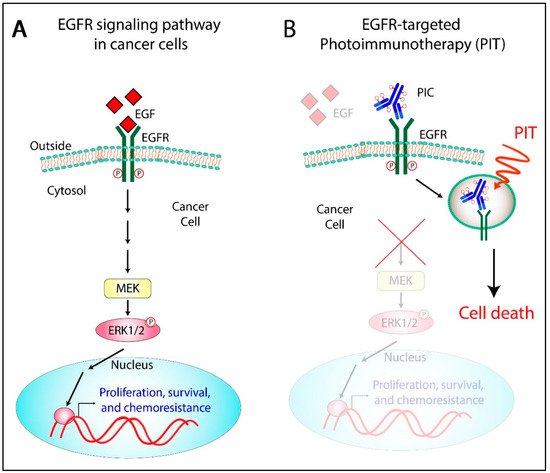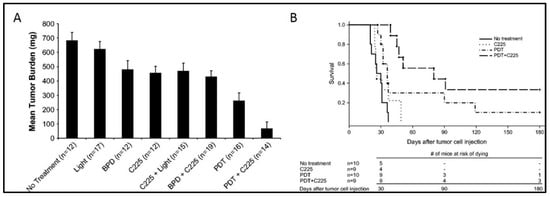A limitation of intraperitoneal PDT in OvCa is the lack of compounds that are both good PSs and good tumor localizers. Although initial preclinical and clinical studies with free PSs demonstrated promising results, their use was limited due to the dose-limiting damage to internal organs
[9][11]. PIT has been explored to circumvent this problem by combining the tumor-localization properties of monoclonal antibodies (MAB) with phototoxic properties of PSs. PIT involves the covalent linkage of a PS to an antibody, creating a PIC. An incubation period following PIC administration allows the antibody to potentially block the targeted receptor activation, followed by uptake and processing of the PIC by the target tissue. By combining the individual modalities, the efficacy of each is improved. Erbitux, for example, recognizes and blocks the epidermal growth factor receptor (EGFR) and is FDA approved for the treatment of metastatic colorectal cancer. EGFR is a rational target because it is overexpressed in 70–90% of advanced OvCa and is associated with aggressive and resistant tumors. Interestingly, some of the early work explored the inhibition of EGFR signaling in combination with benzoporphyrin derivative (BPD)-based PDT. A synergistic response between immunotherapy and PDT was observed with increased survival in vivo
[27]. This was followed by conjugation of PSs to the EGFR antibody to achieve synchronized pharmacokinetics and enhance synergistic treatment outcomes. Growth factor receptor–targeted immunotherapy is suggested to be particularly promising because it exploits blocking the dependence of tumor cells on specific molecular pathways critical for survival and growth. This is made possible by synthesizing PICs in a way that the MAB remains functional in its ability to block receptor signaling. The persistent phototoxicity of PICs due to the “always-on” nature of the PS molecules can be minimized by using tumor-targeted activatable PIT (taPIT) where PS loading on the antibody can be optimized to attain a self-quenched “off state”, which can be activated to an “on state” following target site binding, internalization and lysosomal degradation of the PICs (
Figure 4A–C). This approach of lysosome activated probes has been demonstrated in various studies to enhance specificity and selectivity in therapeutic and diagnostic applications (
Figure 4D,E)
[28][29][30]. While no therapy can be entirely selective, use of EGFR-targeted PIC in OvCa has some significant advantages—(i) EGFR is often overexpressed in OvCa leading to highly selective PS delivery in cancer cells compared to normal tissues, (ii) greater dependence of cancer cells on EGFR signaling, and (iii) confinement of light to the peritoneal cavity
[31].
In addition to providing an additional level of selectivity, the use of MAB-PS conjugates increases the versatility of PDT by allowing the use of compounds that are good PSs but have poor biodistribution properties on their own. MABs have been used for improved diagnosis and therapy of cancer for some time. Radiolabeled and fluorescent MABs
[32][33] have been extensively used for diagnosis and image-guided surgeries
[34][35]. For therapeutic applications, conjugates with radioisotopes, cytotoxic drugs, protein toxins
[36], cytokines
[37], and boron compounds for neutron capture
[38][39] have been investigated. Besides increased selectivity, other potential advantages of PIT over conventional therapy with MAB alone or with MAB coupled to radioisotopes, drugs, or toxins are (i) since it is primarily used as a carrier, the MABs do not require any in vivo effector activity (e.g., complement fixation); (ii) in contrast to most drugs and toxins, the PS can act at the cell membrane as well as intracellularly
[40]; (iii) PIT may stimulate the host immune response which may help eliminate the tumor as demonstrated by Steele et al.
[41] using MAB-HP conjugates. Since the initial report by Mew et al.
[42], we
[14][20][30][43][44][45][46] and others
[47][48][49][50][51][52][53] have demonstrated the feasibility of PICs for the preferential killing of selected cell populations in various systems
[16][19][30][54][55][56]. In the 1990s, Schmidt et al.
[24][25] prepared PICs of MABs recognizing CA125 on human OvCa cells and performed pilot studies of PIT in OvCa patients. While the results were encouraging, technical challenges such as uniform light delivery and toxicity remained.
3. The Rationale to Target EGFR for OvCa Photoimmunotherapy
Growth factor receptors have been recognized as important targets in cancer treatment
[57][58][59][60]. Amongst these, the EGFR family of receptors has attracted significant attention
[61]. The ERBB family of proteins comprises four closely related receptor tyrosine kinases with structural similarity to the epidermal growth factor receptor (EGFR). The four members are human epidermal growth factor receptor 1 (HER1; ERBB1 also called EGFR), HER2 (ERBB2), HER3 (ERBB3), and HER4 (ERBB4)
[62]. Upon ligand binding, EGFR elicits cellular responses through multiple divergent pathways. These pathways control a number of cellular processes, such as growth, motility, and production of growth factors
[63]. The ectodomain of the receptor contains ligand-binding sites, while the protein-kinase catalytic sites are in the intracellular domains. Receptor signaling follows five major pathways
viz. 1) The Ras/Raf/MEK/Erk pathway, 2) STAT pathway, 3) PI3K/AKT pathway, 4) Src kinase pathway, and 5) PLCγ/PKC pathway
[64] (
Figure 6). While the Ras/Raf/MEK/Erk and STAT pathways are involved in cellular differentiation and proliferation, the PI3K/AKT and PLCγ/PKC pathways are important for cell survival and motility, respectively.
Figure 6. Multi-functional epidermal growth factor receptor (EGFR)-targeted PIT. (A) In cancer cells, overexpressed EGFRs bind to the corresponding ligands and promote cell growth, proliferation, metastasis, angiogenesis, etc. (B) The administration of PICs targeting EGFR leads to selective accumulation of the PS in the malignant tissue and inhibition of EGFR signaling pathway and induces localized cell death upon irradiation (right panel).
Under normal conditions, the expression of EGFR in the epithelial lining of ovarian tissue is generally low. However, its overexpression has been reported in 30–98% of OvCa cases
[65] and is thus considered a strong prognostic indicator for OvCa. It binds to various ligands, including EGF and TGF alpha, and contributes to the active malignancy of OvCa by promoting cell growth, cell migration, angiogenesis, and conferring resistance to apoptosis.
Overexpression of EGFR is an attractive and reasonable target for OvCa management; therefore, many antibodies targeting EGFR have been developed and are in clinical use. These include cetuximab, panitumumab, and necitumumab which act by competing with the ligand-binding sites on the extracellular domains of EGFR and inhibiting downstream signaling pathways. Previous studies from our group and others have demonstrated improved therapeutic outcomes with the combination of EGFR inhibition and PDT as compared to monotherapy
[27]. The study by Del Carmen et al. showed a synergistic enhancement of tumor control (
Figure 7A), increased survival, and a 33% cure (
Figure 7B) in mice with disseminated disease treated with both modalities. Conjugation of PS to therapeutic EGFR antibody (Cetuximab), as in PICs, therefore provides a combination therapy with a single therapeutic agent along with a targeting specificity which may overcome the limitations in previous clinical studies
[9][11][66]. Although PDT has been shown to degrade EGFR
[67][68], it also sensitizes cells to EGFR-based inhibitors, thus highlighting the potential of this combinatorial approach. Given the selectivity afforded by the EGFR-based targeting and the simultaneous inhibition of the EGFR-based survival signaling pathways, PIT with EGFR targeting holds great clinical potential where phototoxicity due to non-specific PS distribution has been a limiting factor. Most studies related to PIT of OvCa have been performed with EGFR antibodies, discussed in detail in
Section 3 and
Section 4. Other molecular targets that have been explored in this disease context are discussed in the following section.
Figure 7. (
A) Mean tumor burden for mice treated with either C225 or PDT monotherapy, compared with a combination therapy of C225 and PDT. (
B) Kaplan–Meier survival curves for mice treated with photodynamic therapy only, C225 only, and mice treated with a combination therapy of PDT and C225. Combination treatment with PDT and C225 resulted in a significant enhancement in survival as compared to the individual monotherapies. BPD = benzoporphyrin derivative. PDT = photodynamic therapy. C225 (Cetuximab, Anti-EGFR antibody). Adapted from del Carmen et al. 2005
[27].
4. PIC-Based Combination Therapies
While it has shown considerable promise as a standalone therapy in OvCa, preclinical evidence suggests that PIT is most likely to be effective in combination with other cytotoxic therapies. PIT itself is inherently a combination therapy, as it is composed of a receptor blocking antibody and a phototoxic sensitizer. The therapeutic interaction of these two core components of PIT was examined by del Carmen and colleagues (del Carmen-Hasan 2005) in which anti-EGFR antibody was combined with untargeted PDT in an orthotopic xenograft mouse model. The combination significantly reduced tumor burden and increased animal survival compared to either therapy alone, providing a strong therapeutic rationale for combining PDT and immunotherapy in addition to the inherent selectivity of PIT. PIT has been shown to act synergistically with chemotherapy as well. Both untargeted and targeted forms of the cytotoxic drug SOS thiophene and the PS mesochlorin-e6 were demonstrated to be highly synergistic at low doses by Hongrapipat et al.
[69], suggesting that PIT-based combinations may enable dose reductions of toxic chemotherapies while maintaining efficacy in this highly resistant disease. This effect was confirmed in vivo by Rizvi and colleagues
[70], whereby cisplatin followed by PIT demonstrated comparable or better antitumor effects than 2 cycles of chemotherapy. Additionally, numerous studies have shown that PDT synergizes with various chemo- and radio-therapies in a range of cancer types
[71][72], indicating that this is a fairly generalizable phenomenon.
The resistance to radio- and chemo-therapy agents frequently observed in recurrent OvCa leaves this patient population with few or no treatment options. In this context, PIT makes a compelling case to improve survival outlooks for this disease. Studies by Goff et al.
[20] and Duska et al.
[15] investigated the effects of combined PIT and cisplatin treatment on ex vivo samples from OvCa patients. In both studies, patient tissues resistant to standard chemo- and radio-therapy were demonstrated to be responsive to PIT. In the study by Duska et al., platinum treatment following PIT was demonstrated to have an additive therapeutic effect in cisplatin sensitive cancer cells, while, remarkably, a strong synergistic effect was observed in platinum-resistant cells, suggesting that PIT can resensitize these tumors to chemotherapy (
Figure 3). These data suggest that the use of PIT fills in a crucial niche in the treatment of OvCa, where resistance to chemo- or radio-therapy is a major problem. These types of PIT-based resensitization strategies may hold promise for increasing treatment options in these patients.
The synergistic and re-sensitization effects observed in PIT-based combination therapies such as these may represent a new strategy for managing patients with advanced disease. Typical treatment regimens involve administering the maximum tolerated dose of toxic chemo- or radio-therapies with the hope of eliminating any remaining cancer cells. However, this approach comes with dangerous and often dose-limiting side effects, negatively impacting patient quality of life and limiting these treatments only to those with favorable health status. The non-overlapping toxicity profiles of PIT and chemotherapy, and the ability to reduce the dose of these cytotoxic drugs following PIT-based “priming” of the disease may open up new treatment options for patients who may otherwise not be eligible or responsive to classical therapeutic regimens. Furthermore, optimized PIT regimens that enable dose de-escalation of toxic chemotherapies while maintaining antitumor efficacy hold promise as a means for improving patient quality of life and more humanely treating this devastating disease.




